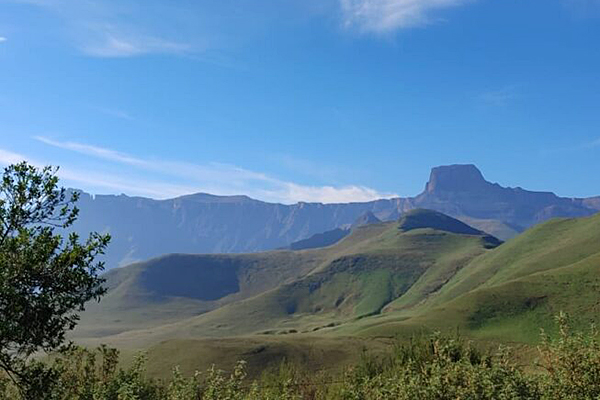Posted: 9 September 2022
The South African ‘RangeX’ Team* and Jake Alexander¹
*Dr Onalenna Gwate, Dr Stephanie Payne, Dr Sandy-Lynn Steenhuisen and Dr Ralph Clark – Afromontane Research Unit (ARU) & Departments of Geography and Plant Sciences, University of the Free State: Qwaqwa Campus, South Africa
¹Project Co-ordinator and overall ‘RangeX’ Principal Investigator, Plant Ecology, ETH Zürich, Switzerland
In mountains where plant responses to global climate change are being monitored, plant species are (on average) moving uphill towards higher elevations. But – there is great variation between species in the extent of this uphill migration. And for many mountains there are no data at all as to how species are behaving. A key challenge then is how to adequately forecast individual species’ responses to climate change – especially for species that have management implications, such as invasive species, or plants that have social or economic benefits.
Some ideas as to what might be affecting differences in responses include different abilities to disperse and propagate, and barriers to establishing in new environments. Experiments are needed to explore these possibilities, and to test the results of experimental treatments in real life-observed changes in distributions.
The “RangeX” project is working on untangling some of these ideas, through a global consortium led by ETH Zürich (Switzerland). Aspects of RangeX are being simultaneously rolled out in Switzerland, Australia, Canada, Chile, China, Denmark, France, Germany, India, Norway, South Africa, and the United States.
The South African component – where there is very limited empirical data on the behaviour of mountain plant species in response to climate change – has successfully completed almost a year of novel work. This includes the first known open top chamber (OTC) experiments in the alpine zone of the Maloti-Drakensberg in South Africa, at 3,100 m above sea level, with a control site at 2,300 m above sea level (without chambers). South Africa and Lesotho have major problems with rapidly expanding ranges of non-native and native woody species in their mountains – affecting fire regimes, rangeland-based biodiversity, conservation of the rich endemic montane grassland biodiversity, and dramatic impacts on water provision from catchments. But we do not know if the current alpine zone would be affected under future climate scenarios by the upward migration of woody species.
Currently, woody species in the Maloti-Drakensberg (other than some extremely tough shrubs) are confined to a maximum elevation of c.2,600 m, with extreme conditions in the summit (mostly above 3,000 m) limiting recruitment and survival. These conditions include winter temperatures down to -20oC, high UV, cryogenic soil activity for much of the year, winds up to 100 km/hr, and strong seasonal aridity. While recruitment may be possible in summer, it is likely that the sub-polar winter conditions quickly wipe out any recruits. Also, the 1 km high – generally shear – escarpment may form a geomorphological dispersal barrier to many species, although extreme topography has not been a deterrent to most problem woody species in other mountains in South Africa. It may also be that dispersal agents for many woody species decline to venture that high up…!
However, should current alpine conditions ameliorate to favour woody species, there may be a catastrophic cascade effect across the (then former) relatively featureless (plateau) alpine zone of the Maloti-Drakensberg – with all the implications involved. Our modest, 400 m2 experiment on the summit provides a sneak peak into “what might be” for this alpine zone in a 5oC warmer-mountain scenario. To try to get an all-round perspective, we included a mix of non-native woody species that are problematic in the Maloti-Drakensberg, together with native woody problem species and a guild of species representing succulent, bulb, and grass functional groups (unrelated species with similar looks). So, for example, would Aloes and Pigs Ears (Cotyledon) that do very well currently at 2,000 m in the Maloti-Drakensberg do well on the summit at 3,000 m in 20 years’ time? And could we see Sage-leaved Buddleja (Buddleja salviifolia) – very happy at 2,600 m – colonising summit watercourses in the year 2030? Does Lesotho and South Africa need to plan for joint Australian Wattle (e.g. Acacia dealbata) or Crack Willow (Salix fragilis) management in the highest reaches of the Maloti-Drakensberg in the next 20 years, as part of their shared transboundary programme?
Having successfully had the experiment in place for almost a year – with logistical excitement that will become immortalised around camp fires – we have some interesting outcomes. Preliminary summer season results show that the highest mortality was the combination of {vegetated plots + focal plants – OTCs}, whereas {bare plots + focal plants + OTCs} had the lowest mortality. The {vegetated plots + focal plants + OTCs} and {bare plots + focal plants – OTCs} had the same mortality. We have not yet determined which functional groups did better or worse. However, these results suggest that during the summer season competition from pre-existing native vegetation is a limiting factor, rather than just dispersal limitation along an elevational gradient – but of course the alpine climate even in summer could be an excluding factor on its own. Having said that, it was obvious that many individual plants on the summit site were not at all happy, and were heavily impacted by hail (some plants never recovered), cold temperatures (even in summer), frost, and possibly soil ice.
We also deployed a system of remote, time-lapse cameras to both sites (summit and control sites), which took photographs of the plants at five-minute intervals for the entire summer season (November 2021 to May 2022). We are in the process of analyzing the thousands of photographs taken, but they will allow us to detect if there is a difference in the potential dispersal agents and pollinators between the two elevations that may be enabling the rangeexpansion of the selected plants. We will also be able to tell if the same pollinators are responsible for pollination at both elevations, or if an entirely new cohort of pollinators takes over at the summit. Additionally, the photographs provide information on weather events (hail, frost, snow) that impacted the plants, as well as changes in the growth and flowering patterns of the plants over the summer season. The incidental weather information captured by the cameras (temperature records and precipitation visuals) provides a first glimpse of conditions at this particular study site.
We are yet to quantitatively determine the impact of the winter on both sites, but initial evidence in August 2022 is revealing that numerous woody plants in the Open Top Chambers survived the winter – suggesting that we may indeed see potential for lower elevation woody species establishing on the summit under future ameliorated temperature regimes. This would have massive implications for policy, management and livelihoods in the alpine zone of the Maloti-Drakensberg.
As the project is only half-way through, with a lot of existing data to process and new data to collect, we expect many more surprises as we learn about the current Maloti-Drakensberg alpine system and “what could be” in future from climate change and other factors.
A complex project of this nature is not possible without much help and teamwork. The ZA RangeX Team thanks the South African Department of Science & Innovation (DSI; for the BiodivERsA grant to the ARU, and for the ARU’s Risk & Vulnerability Science Centre programme Grant No. 128386 to VRC), the University of the Free State (post-doc stipends for OG and SP), ETH Zürich (additional financial support around logistics), and Aarhaus University (for cameras). Witsieshoek Mountain Lodge & Transfrontier Parks Destinations are thanked for permission to place the sites in their management area; for managing the security team logistics; providing discounts on accommodation and waiving access / hiking fees; and assisting in a hundred other different ways. The services of the RangeX security team, BNQ Services (technical assistance), Nkosi Nursery (plants), and Westline Aviation (helicopter services) are all deeply appreciated. The Free State Department of Small Business Development, Tourism and Environmental Affairs (DESTEA) is thanked for the necessary permits. The assistance of Muxe Dlomu, Marc Achermann, Evelin Iseli, and Jamie Allison in setting up the experiment under very challenging conditions is deeply appreciated.
The Amphitheatre in the Maloti-Drakensberg. The ZA RangeX summit site is on the summit to the right of the Sentinel (the large block peak in the centre right) (Photo: S. Payne).


